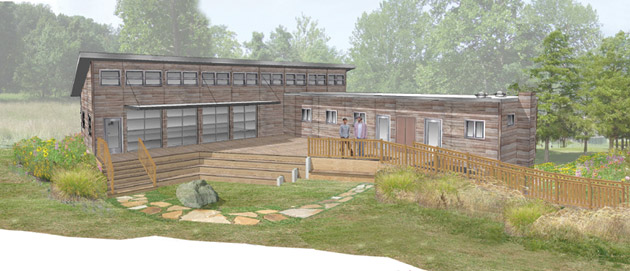You may be familiar with LEED, the U.S. Green Building Council’s green building certification standard, but now there is a new, more demanding system on the scene. The more stringent Living Building Challenge (LBC), endorsed by USGBC, strives to be the most advanced green building rating system in the world.
One of the first two buildings competing to become the first LBC-certified project is the new Living Learning Center at the Tyson Research Center, part of Washington University in St. Louis, Missouri.

LEED and LBC differ in two substantial ways. Whereas LEED operates on a point-scoring system, all sixteen of Living Building Challenge’s elements, in the categories of Site, Energy, Materials, Water, Indoor Quality, and Beauty & Inspiration, are mandatory. And, while LEED designation measures anticipated performance, LBC measures actual performance over a building’s first year. LBC features strict requirements on building material transportation distance, bans on certain chemicals, net-zero water and energy usage, among its sixteen requirements.
The Living Learning Center’s opening ceremony was May 29, 2009. If the Living Learning Center succeeds, it will earn its LBC certification by June 2010.

Also note that the USGBC has added still more certification options to the acronym soup with the recent release of “LEED 2009,” an update to the credit system as part of the new-and-improved LEED v3. The new standard places even more focus on energy efficiency… something we’re (E2.0 & CEA) all for, but hardly the only environmental impact of a brown building. On the other hand, local projects can receive “extra credit” for brownfield redevelopment and structure reuse*, stormwater management, reducing heat island effects, and on-site renewables.
* Or sustainable food purchasing, solid waste management, and air-borne particulate reduction for existing buildings.
LEED has made almost zero impact on bringing existing buildings into any form of energy efficiency. Being certified for anything is a joke unless and until monitoring and verification is used AFTER completion to then issue some basis and a corresponding type of ‘certification’. The LEED ‘points’ system needs serious revisions. I don’t care what your “LEED Cert” says; let me see your utility bills.
Please note that LEED was originally intended for new construction, and only relatively recently developed (looser) standards for existing buildings. Also note that monitoring and verification an optional point in many LEED standards) is not relevant for all measures. For instance, actual subject of this post, the LBC, requires the construction of a net-zero energy building… and it doesn’t take much effort to see that the annual sum of one’s utility bills is $0 (or negative).
LEED EB is in fact not a recent designation. In any event the LBC is an ugly building and furthermore one does not need ANY LEED ‘points’ to develop a net-zero energy building, just a good engineer, good systems and good construction.
Mr. Skeptic, please read carefully before reacting and responding to things unsaid. I stated that EB was *relatively* recent. LEED began in 1998, and the variants began emerging circa 2002. Likewise, I did not say that a ZEB required LEED or LEED points, I simply pointed out that that LEED did offer an incentive (albeit a small one) for the monitoring and verification you crave. However I disagree, a ZEB* requires far more than simply good systems e.g; conscientious tenants and efficient appliances to lower plug loads.
*Constructed at a reasonable price, that is not merely a big box with lots of renewables slapped on the side.
LBC (Living Building Challenge) is not a building, but a rating system.
LBC requires much more than net-zero energy. For instance, the building materials cannot be toxic (no PVC, no creosote, no formaldehyde, etc.), and must come from within a certain radius. See LBC’s website for more information on their “petals” (requirements).